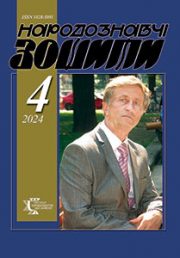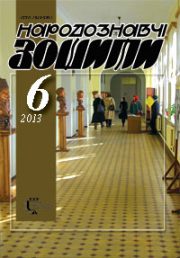The Ethnology Notebooks. 2020. № 5 (155), 1051—1063
UDK 393:133.4(477.85/.87) (=1.23)
DOI https://doi.org/10.15407/nz2020.05.1051
PROPERTIES OF A DEAD HUMAN BODY IN HUTSUL MAGIC PRACTICES
IVANCHUK Vasyl
- ORCID ID: https://orcid.org/0000-0001-8251-8708
- Post-graduate student of archeology and ethnology department
- Vasyl Stefanyk Precarpatian National University,
- Shevchenko street, 57, 76018, Ivano-Frankivsk, Ukraine,
- Contacts: e-mail: vasylivanchuk994@gmail.com
Abstract. Today’s variable involvement in magic activities of the body and the possessions of the deceased in Hutsul ethnolocal tradition, and the absence of special research in this sphere determine the scientific importance of the investigation. The goal of the article is to trace and to analyze different Hutsul household magic practices that are based on the usage of a dead human body and the things that touched it became a medium of its physical characteristics. The object of the research is traditional magic rites of the inhabitants of Hutsulshchyna; and the subject is the usage of the body of the deceased and its substitutes in contagious and imitative magic. The investigations is based on well-known methodology in ethnological science: typological, structural-functional, comparative.
Household magic activities, in which properties of the body of the deceased and its substitutes are used, are examined on the basis of ethnographic descriptions of the late 19th and the early 20th centuries, and modern field case study from Hutsulshchyna area and foreign ethnic locations. Depending on the actional and meaningful impacts of this or that rite, all such activities are based on contagious and, in certain cases, imitative magic; sometimes on their combined action. A superficial study of the problem revealed an ambivalent nature of the body of the deceased: on the one hand, its physical parts, as well as things that were in contact with it, produce harm; but on the other hand, positively solve certain situational household problems. However, dual, according to a modern moral-ethical perception, abilities of the body of the deceased are only conditional, since every magic rite is realized on a common sense basis due to retranslation of physical features of a dead human or their derivative mental and physical states: lifelessness, death, sickness, inadequacy, solidity, indifference, drowsiness, staticity, blindness, mutism, semantics of end, ending.
Within the research we denied the thesis stating that the supernatural features genesis of the substitutes of a deceased is a functional characteristic of an ancestry cult, since we consider magical abilities of these things to be a result of thinking and household contemplation of people that discovered in the deceased accordant physical features and began to transfer them by analogy to things and processes of the surrounding world.
Keywords: Hutsulshchyna, Hutsuls, magic, dead body, substitutes of a deceased.
Received 3.08.2020
REFERENCES
- Vytvytskyi, S. (1993). A historical essay is about guzuls. Kolomyia: the World [in Ukrainian].
- Wajgiel, L. (1887). Аbout guzuls. Ethnographic contours. Krakow [in Polish].
- Kajndl’, R.F. (2000). Hutsuls: their lives, customs and folk traditions. Chernivtsi: molodyj bukovynets’ [in Ukrainian].
- Shukhevych, V. (1908). Hutsul’schyna. From «General Printing-house» (Vol. 5). Lviv [in Ukrainian].
- Onyschuk, A. (1912). Funerals customs and ceremonies in villages Zelenytsya, Nadvirna district. Etnohrafichnyj zbirnyk, ХXXI—XXXII, 231—252 [in Ukrainian].
- Onyschuk, A. (1909). Materials of gucul’skoy demonologii. Wrote down in villages Zelenytsya, Nadvirna district. Materials to Ukrainian etnology, ХІ, 1—139 [in Ukrainian].
- Bogatyrev, P.G. (1971). Magic acts, rites and beliefs in Transcarpathia. In Questions of the theory of popular art (Pp. 167—296). Моscow: Art [in Russian].
- Potushnyak, F. (1941). Samogubci in folk beliefs. Literary resurrection. Richnik And. (Pp. 21—22; 31—32).Ungvar: Printing-house of Pidkarpatskogo of society of sciences [in Ukrainian].
- Konobrodska, V. (2007). Poliskiy burial place and mention ceremonies. Etnolingvistic studios (Vol. 1). Zhytomyr [in Ukrainian].
- Voitovich, N. (2015). Folk Demonology of Boykivshchyna. Lviv [in Ukrainian].
- Kuzminska, B. (2012). «Walking dead persons» are in the modern beliefs of opilyan. Question of ancient and medieval history, archaeology and ethnology, 1, 239—258 [in Ukrainian].
- Varkhol, N. (2012). Folk knowledges of ukrainciv-rusiniv of Slovakia. Folk ART and Ethnography, 4, 33—45 [in Ukrainian].
- Nesen, I. (2009). Burial place and mention ceremonies are in the environment of «outlying» gentry of North-eastern Zhytomyrschyna (end ХІХ – beginning of ХХ cen.). Announcer of Lviv University, series of history, 44, 241—264 [in Ukrainian].
- Cherleniak, I. (2018). Protective action for alive and magik action connected with the burial of the deceased of the Transcarpatian Ukrainians. The ethnology notebooks, 3, 662—670 [in Ukrainian].
- Ulianovska, S. (1992). Imitativna magic in ordinariness of guzuls of Verkhovynschyna. Folk ART and Ethnography, 2, 69—73 [in Ukrainian].
- Krasykov, M. (2013). Imitativna magic in ordinariness of guzuls of Verkhovynschyna. Folk ART and Ethnology, 6, 27—36 [in Ukrainian].
- Kis, R. (1996). Covariances of pictures of death is as indicator of culture: attempt of kros-cultural vision. Studios are from integral kul’turologii, Thanatos, 1, 9—21 [in Ukrainian].
- Kabakova, G.I. (1999). Children are not baptized. Slavic mythology: Encyclopedic dictionary (Pр. 86—88). Моscow [in Russian].
- Sedakova, O. (2004). Poetics of the rite. Funeral rites of the Eastern and Southern Slavs. Моscow: Indrik [in Russian].
- Levkievskaya, E.E. (2002). The slavonic guarded. Semantics and structure. Moscow: Indrik [in Russian].
- Frezer, Dz. (2001). Gold branch: Research of magic and religion: in 2 vol. (Vol. 1). Moscow: TERRA the Book club [in Russian].
- Kagarov, E. (1928). Forms and elements of folk rite. Primitive citizenship and its vestiges are in Ukraine. Scientific annual is after an editor Kateryna Grushevska (Issue I, pp. 21—56). Kyiv [in Ukrainian].
- Tokarev, S.A. (1959). Sens and origin of magic. Researches and materials on questions of primitive religious beliefs. Trudy Instituta ethnographyi, 51, 17—29. Moscow [in Russian].
- Izvorin, Ad. (1942). Pidkarpatski rusini has consuetudes of burial place. Sunset — Hajnal. Chasopis’ Pidkarpatskogo societies of sciences, 1—2, 130—143 [in Ukrainian].
- Onyschuk, A. (1917). Folk medicine (medications), folk beliefs. It is written in Zelenci Nadvirnyanski district. Archive of funds of manuscripts and fonozapisiv of IMFE the name of M.T. Ril’skogo NAN of Ukraine (Archive of funds of manuscripts and fonozapisiv Institute of study of art, specialist in folk-lore and ethnology of the name of M.T. Ril’skogo, the National academy of sciences of Ukraine). F. 28. Op. 1. Od. save 392. Arc. 1—31 [in Ukrainian].
- Potushnyak, F. (1942). Water, earth and air (in a folk belief). Sunset — Hajnal. Chasopis’ Pidkarpatskogo societies of sciences, 1—2, 371—373 [in Ukrainian].
- Sventsytskyi, I. «As the main zanemozhe». Funerals are in Krivorivnia. Description of ceremony. Archive of funds of manuscripts and fonozapisiv of IMFE the name of M.T. Ril’skogo NAN of Ukraine. F. 28. Op. 1. Od. save 538. Arc. 1—3 [in Ukrainian].
- Kisilevska, Ol. (1912). Funeral consuetudes and ceremonies are in Tovmachik, Kolomiyskogo pov. Etnohrafichnyj zbirnyk, ХXXI—XXXII, 299—302 [in Ukrainian].
- Mikhayleckiy, O. (1912). Pokhoronni consuetudes and ceremonies in Trostyanec, Snyatinskogo povita. Etnohrafichnyj zbirnyk, ХXXI—XXXII, 302—315 [in Ukrainian].
- Tivodar, M.P. (2011). Etnografiya Zakarpattya: Istoriko-etnografichniy essay. Uzhgorod: Grazhda [in Ukrainian].
- Schnaider, J. (1912). Gettings of highlanders … (Finishing). People, XVIIІ, 141—217 [in Polish].
- Pereyma, T. (1912). Pokhoronni consuetudes and ceremonies in the village of Ropicya to Ruskiy, Gorlickogo pov. Etnohrafichnyj zbirnyk, ХXXI—XXXII, 203—209 [in Ukrainian].
- Botik, J. (2001). Common traditions of death and burial in Slovakia: with special regard to ethnic and confessional diversity. Slovak National Museum, Bratislava [in Slovakian].
- Franko, I. (1898). Popular beliefs in Pidhiria. Etnohrafichnyj zbirnyk (Vol. V, pp. 160—218) [in Ukrainian].
- Rakova, Ol. (1912). Funeral consuetudes and ceremonies are in the village of Raranchu, Chernoveckogo pov. Etnohrafichnyj zbirnyk, ХXXI—XXXII, 338—347 [in Ukrainian].
- Onyschuk, A. (1912). Funerals, customs and ceremonies in villages Karlovi Snyatyn district. Etnohrafichnyj zbirnyk, ХXXI—XXXII, 315—338 [in Ukrainian].
- Petrukhyn, V.Ya. (1994). Istoriko-ethnographic researches on folklore. East literature. Moscow [in Russian].
- Schnaider, J. (1907). People of Peczenizhinski (Part II). People, XIII, 21—33; 98—117 [in Polish].
- Baiburyn, A.K. (1992). Belt (to the semiotics of things). From the cultural legacy of people of Eastern Europe (Pp. 5—13). SPb.: Science [in Russian].
- Smyrnov, V. (1920). Folk funerals and lamentations are in the Kostromskom edge. Second etnogr. sb. Kostroma [in Russian].
- Derkach, V. (1912). Funerals customs and ceremonies in villages Verbivtsi, Terebovelsky district. Etnohrafichnyj zbirnyk, ХXXI—XXXII, 369—378 [in Ukrainian].
- Tolstoy, N. (1995). Gallows-bird. Slavic mythology: Encyclopedic dictionary (Pр. 377—379). Моscow [in Russian].
- Zelenin, D.K. (1995). Izbrannye labours: Essays of Russian mythology: Dyings unnatural death and mermaids. Moscow: Indrik [in Russian].
- Konopka, V. (2017). From the folk spiritual culture of Ukrainians of Bukovyna, Gucul’schina: materials of the field researches. The ethnology notebooks, 3, 731—736 [in Ukrainian].
- Tolstoy, N.I. (1996). Yazychestvo of drevnikh slavyan. Ocherki istori I kul’tury slavyan. Moscow: Indrik [in Russian].
- Levkievskaya, E.E. (2009). Suicide. Slavic mythology: Encyclopedic dictionary (Pр. 538—541). Моscow [in Russian].
- Moisei, A. (2008). Magiya and mantika in the folk calendar of skhidno romanskogo population of Bukovyna. Tchernivtsi: Seal of Art [in Ukrainian].
- Lysynetska, K. (1902). Translations, stories, beliefs, songs. It is written in Kosmach, Solotvinskogo r-nu, Stanislavivskoyi obl. Archive of funds of manuscripts and fonozapisiv of IMFE the name of M.T. Ril’skogo NAN of Ukraine. F. 28. Op. 1. Od. save 170. Arc. 1—14 [in Ukrainian].
- Demyan, L. (1926). Pokhoronni ceremonies and beliefs from Verechansky district. Pidkarpatska Rus (Pp. 108—123; 170—175). Uzhgorod: Pedagogical society of Podkarpatska Rus [in Ukrainian].
- Fischer, A. (1928). Rusini: outline of ethnography of Rus. Lviv; Warsaw; Krakow [in Polish].
- Pelka, L. (1987). Polish folk demonology. Warsaw [in Polish].






